Psyche is the Greek term for "soul" (ψυχή).

Bertel Thorvaldsen was a Danish and Icelandic sculptor medalist of international fame, who spent most of his life (1797–1838) in Italy. Thorvaldsen was born in Copenhagen into a working-class Danish/Icelandic family, and was accepted to the Royal Danish Academy of Art at the age of eleven. Working part-time with his father, who was a wood carver, Thorvaldsen won many honors and medals at the academy. He was awarded a stipend to travel to Rome and continue his education.
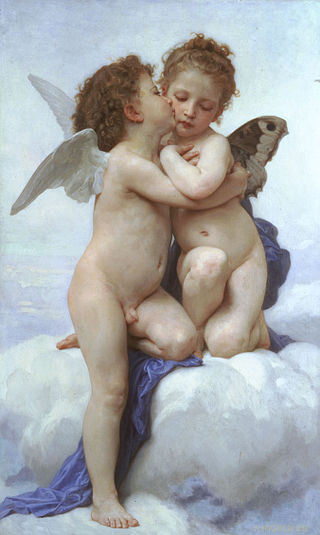
L'Amour et Psyché, enfants is an oil painting by William Adolphe Bouguereau in 1890. It is currently in a private collection. It was displayed in the Salon of Paris in 1890, the year Bouguereau was President of the Société des Artistes Français. The painting features Greek mythological figures Eros and Psyché, sharing an embrace and kiss. Bouguereau was a Classical-style painter in the Neoclassical era of art. The painting is characterized by the frothy background the figures delicately stand on. It depicts the beginning of the forbidden romance of Cupid and Psyche, a popular subject at the time of execution.
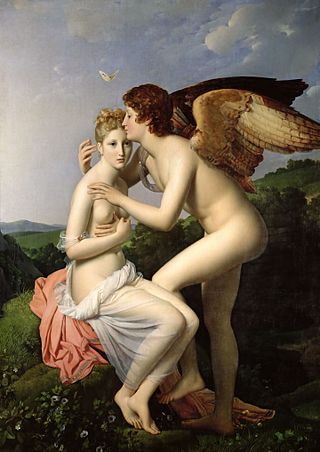
Cupid and Psyche is a story originally from Metamorphoses, written in the 2nd century AD by Lucius Apuleius Madaurensis. The tale concerns the overcoming of obstacles to the love between Psyche and Cupid or Amor, and their ultimate union in a sacred marriage. Although the only extended narrative from antiquity is that of Apuleius from 2nd century AD, Eros and Psyche appear in Greek art as early as the 4th century BC. The story's Neoplatonic elements and allusions to mystery religions accommodate multiple interpretations, and it has been analyzed as an allegory and in light of folktale, Märchen or fairy tale, and myth.

John Gibson was a Welsh Neoclassical sculptor who studied in Rome under Canova. He excelled chiefly in bas-relief, notably the two life-size works The Hours Leading the Horses of the Sun and Phaethon driving the Chariot of the Sun, but was also proficient in monumental and portrait statuary. He is famous for his statues of Sir Robert Peel, William Huskisson and Queen Victoria. Gibson was elected a Royal Academician in 1836, and left the contents of his studio to the Royal Academy, where many of his marbles and casts are currently on display.
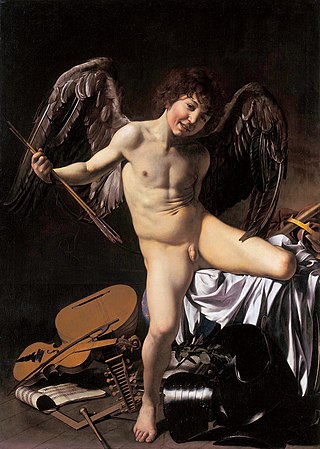
Amor Vincit Omnia is a painting by the Italian Baroque artist Caravaggio.

Psyche Revived by Cupid's Kiss is a sculpture by Italian artist Antonio Canova first commissioned in 1787 by Colonel John Campbell. It is regarded as a masterpiece of Neoclassical sculpture, but shows the mythological lovers at a moment of great emotion, characteristic of the emerging movement of Romanticism. It represents the god Cupid in the height of love and tenderness, immediately after awakening the lifeless Psyche with a kiss. The story of Cupid and Psyche is taken from Lucius Apuleius' Latin novel The Golden Ass, and was popular in art.
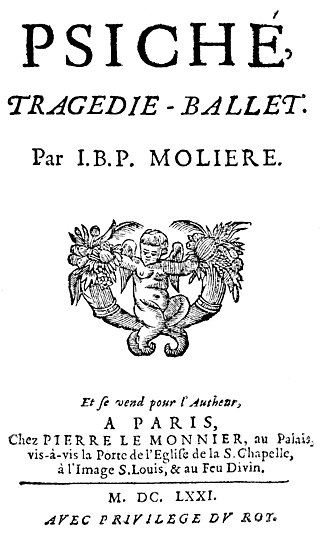
Psyché is a five-act tragicomédie et ballet, originally written as a prose text by Molière and versified in collaboration with Pierre Corneille and Philippe Quinault, with music composed by Jean-Baptiste Lully in 1671 and by Marc-Antoine Charpentier in 1684. The plot is based on the story of Cupid and Psyche in The Golden Ass, written in the 2nd century by Apuleius. It was first performed on 17 January 1671 before the royal court of Louis XIV at the Théâtre des Tuileries, with ballets by Pierre Beauchamps, Anthoine des Brosses, and Nicolas Delorge, and spectacular scenery and special effects designed by Carlo Vigarani.

In Greek mythology, Eros is the Greek god of love and sex. His Roman counterpart was Cupid ("desire"). In the earliest account, he is a primordial god, while in later accounts he is described as one of the children of Aphrodite and Ares and, with some of his siblings, was one of the Erotes, a group of winged love gods.

The Thorvaldsen Museum is a single-artist museum in Copenhagen, Denmark, dedicated to the art of Danish Neoclassical sculptor Bertel Thorvaldsen (1770–1844), who lived and worked in Rome for most of his life (1796–1838). The museum is located on the small island of Slotsholmen in central Copenhagen next to Christiansborg Palace. Designed by Michael Gottlieb Bindesbøll, the building was constructed from 1838 to 1848 following a public collection of funds in 1837.

In classical mythology, Cupid is the god of desire, erotic love, attraction and affection. He is often portrayed as the son of the love goddess Venus and the god of war Mars. He is also known in Latin as Amor ("Love"). His Greek counterpart is Eros. Although Eros is generally portrayed as a slender winged youth in Classical Greek art, during the Hellenistic period, he was increasingly portrayed as a chubby boy. During this time, his iconography acquired the bow and arrow that represent his source of power: a person, or even a deity, who is shot by Cupid's arrow is filled with uncontrollable desire. In myths, Cupid is a minor character who serves mostly to set the plot in motion. He is a main character only in the tale of Cupid and Psyche, when wounded by his own weapons, he experiences the ordeal of love. Although other extended stories are not told about him, his tradition is rich in poetic themes and visual scenarios, such as "Love conquers all" and the retaliatory punishment or torture of Cupid.

The Visitors is an opera in three acts and a prologue composed by Carlos Chávez to an English libretto by the American poet Chester Kallman. The work was Chávez's only opera. Its first version, with the title Panfilo and Lauretta, premiered in New York City in 1957. The final version with the title The Visitors was premiered in Guanajuato, Mexico in 1999, twenty years after the composer's death. The story is set in 14th century Tuscany during the time of the Black Death. The libretto uses the device of a play within a play to reflect and intensify the relationships between the protagonists, who in this case are loosely based on characters in The Decameron.

The marble Cupid and Psyche conserved in the Capitoline Museums, Rome, is a 1st or 2nd century Roman copy of a late Hellenistic original. It was given to the nascent Capitoline Museums by Pope Benedict XIV in 1749, shortly after its discovery. Its graceful balance and sentimental appearance made it a favourite among the neoclassical generations of artists and visitors, and it was copied in many materials from bronze to biscuit porcelain. Antonio Canova consciously set out to outdo the Antique original with his own Cupid and Psyche of 1808
Amor und Psyche is an opera (singspiel) in four acts composed by Ludwig Abeille to a German libretto by Franz Carl Hiemer (1768–1822). Based on the story of Cupid and Psyche, the opera premiered on January 18, 1800, at the Hoftheater (Herzöglichestheater) in Stuttgart. Amor und Psyche was popular in Germany in its day and a version of the score for voice and piano was published by Breitkopf & Härtel. Franz Carl Hiemer went on to write the libretto for Abeille's third opera, Peter und Ännchen (1809) as well as the libretti for Carl Maria von Weber's operas Silvana and Abu Hassan.

Love and Psyche or Cupid and Psyche is an 1817 painting by Jacques-Louis David, now in the Cleveland Museum of Art. It shows Cupid and Psyche. It was produced during David's exile in Brussels, for the patron and collector Gian Battista Sommariva. On its first exhibition at the museum in Brussels, it surprised viewers with its realist treatment of the figure of Cupid. Critics generally saw the painting's unconventional style and realistic depiction of Cupid as proof of David's decline while in exile, but art historians have come to see the work as a deliberate departure from traditional methods of representing mythological figures.
Cupid and Psyche is a story in Greek and Roman myth.

Bacchus, Venus and Cupid is a 1531-1532 oil on canvas painting attributed to Rosso Fiorentino, now in the National Museum of History and Art in Luxembourg.
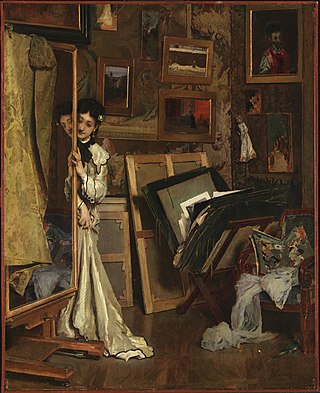
The Psyché is an oil on panel painting by the Belgian artist Alfred Stevens. Painted in circa 1871, the painting once belonged to Robert de Montesquiou, and is currently housed at the Princeton University Art Museum located in Princeton, New Jersey.
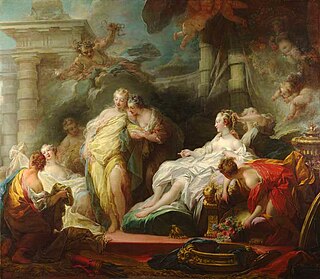
Psyche Showing Her Sisters Her Gifts from Cupid is an oil painting by the French artist Jean-Honoré Fragonard, painted in 1753, in the National Gallery in London. Its dimensions are 168.3 by 192.4 cm.
















